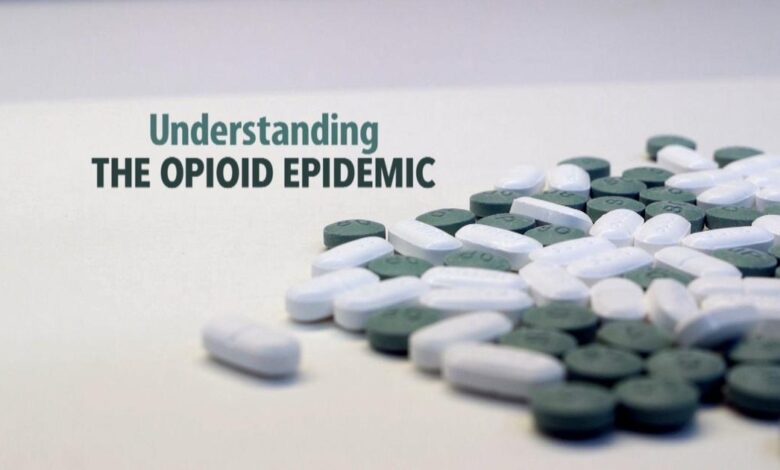The Opioid Epidemic: Understanding the Crisis, Impact, & solutions

Opioids are a class of drugs that include both prescription pain relievers such as oxycodone, hydrocodone, and morphine, as well as illegal drugs like heroin. They are potent painkillers that work by binding to opioid receptors in the brain, reducing the perception of pain. While they can be effective in managing severe pain, they also carry a high risk of addiction and overdose.
Prescription Pain Relievers, Illegal Drugs, and the Risks of Addiction and Overdose
- The Opioid Epidemic: A Growing Crisis
The United States is currently facing an opioid epidemic, with a significant increase in opioid-related deaths and addiction rates over the past few decades. This crisis has been fueled by a combination of factors, including overprescribing of opioid medications, widespread availability of illicit opioids, and lack of access to effective treatment for addiction.
- Impact on Public Health
The impact of the opioid epidemic on public health has been devastating. According to the Centers for Disease Control and Prevention (CDC), over 500,000 people have died from opioid overdoses in the United States since 1999. This includes deaths from both prescription opioids and illicit opioids like heroin and fentanyl. In addition to overdose deaths, opioid addiction has led to increased rates of infectious diseases such as HIV and hepatitis C due to needle sharing among intravenous drug users.
- Social and Economic Consequences
The opioid epidemic has also had significant social and economic consequences. Families and communities have been torn apart by addiction, with many individuals struggling to hold down jobs or maintain relationships due to their substance use disorder. The economic costs of the epidemic are also substantial, including healthcare expenses for overdose treatment, lost productivity, and increased law enforcement and criminal justice costs.
- Factors Contributing to the Epidemic
Several factors have contributed to the rise of the opioid epidemic. One major factor is the aggressive marketing and promotion of opioid medications by pharmaceutical companies in the 1990s and early 2000s. This led to a dramatic increase in the prescription of opioids for chronic pain, often without sufficient regard for the risk of addiction. Additionally, the availability of cheap and potent synthetic opioids like fentanyl has made illicit opioids more accessible and deadly.
- Challenges in Addressing the Crisis
Addressing the opioid epidemic is a complex challenge that requires a multifaceted approach. One of the primary challenges is ensuring access to effective treatment for individuals struggling with opioid addiction. Medications such as methadone and buprenorphine can help reduce cravings and withdrawal symptoms. Still, there are often barriers to accessing these treatments, including stigma, cost, and lack of healthcare providers trained in addiction medicine.
Prevention and Harm Reduction Strategies
Prevention and harm reduction strategies are also critical in addressing the opioid epidemic. This includes efforts to reduce the overprescribing of opioids by healthcare providers through education and guidelines, as well as increasing access to naloxone, a medication that can reverse opioid overdoses. Needle exchange programs and supervised injection sites have also been shown to reduce the spread of infectious diseases and overdose deaths among injection drug users.
- Policy and Legislative Responses
Governments at the federal, state, and local levels have implemented various policy and legislative responses to combat the opioid epidemic. This includes measures to improve prescription drug monitoring programs, increase access to addiction treatment services, and enhance enforcement efforts to disrupt the supply of illicit opioids. Some states have also implemented limits on opioid prescribing and expanded Medicaid coverage for addiction treatment.
- Community and Supportive Services
Community-based initiatives and supportive services play a crucial role in addressing the opioid epidemic. This includes peer support programs, counseling services, and outreach efforts to connect individuals with addiction treatment and recovery resources. Education and awareness campaigns are also essential in reducing stigma and promoting understanding of opioid addiction as a treatable medical condition.
- The Road to Recovery
While the opioid epidemic continues to present significant challenges, there is hope for recovery and progress. Increased awareness, improved access to treatment, and collaborative efforts between healthcare providers, policymakers, and communities are critical components of a comprehensive response to the crisis. By addressing the underlying factors contributing to opioid addiction and implementing evidence-based interventions, we can work towards a future where fewer lives are lost to this devastating epidemic.
The opioid epidemic remains a critical public health issue with far-reaching consequences for individuals, families, and communities. Understanding the factors contributing to the epidemic, implementing effective prevention and treatment strategies, and fostering collaboration across sectors are essential in addressing this crisis. By prioritizing evidence-based approaches and investing in resources to support recovery, consider Pacific Ridge, and we can work towards a healthier and safer future for all.



